Abstract
Modifications in donor screening and the introduction of laboratory testing of donated blood for anti-HIV-1 and anti-HTLV-I have resulted in a significant reduction in the risks of retroviral infections from blood transfusion. Presently, the American Red Cross detects an average of eight carriers of human immunodeficiency virus, type 1 (HIV-1) per 100,000 otherwise acceptable blood donors (0.008 percent), compared with an average of 35 per 100,000 (0.035 percent) when testing for HIV-1 antibodies began in 1985. Surveillance studies in the United States indicate a small likelihood that HIV-2 carriers will pass current screening procedures and be accepted as blood donors. Even if an HIV-2-infected person were to be accepted as a blood donor, there is a 42-92 percent likelihood that this person's blood would be detected as infective for HIV-2 and excluded because of serological cross-reactions that occur in the EIA for HIV-1 antibodies. During 1989, which was the first year that donated blood was routinely tested for antibodies to human T-lymphotropic virus, type I (HTLV-I) in the United States, approximately nine in 100,000 donors (0.009 percent) were confirmed positive for antibodies to HTLV-I, and their donated blood was excluded. Subsequent testing has revealed that a significant number of these persons whose sera was reactive by the HTLV-I EIA were, in fact, infected by HTLV-II. Epidemiological studies of human retroviral infections (HIV-1, HIV-2, HTLV-I, and HTLV-II) continue to provide important data and direction for improving criteria for qualifying blood donors.
Full text
PDF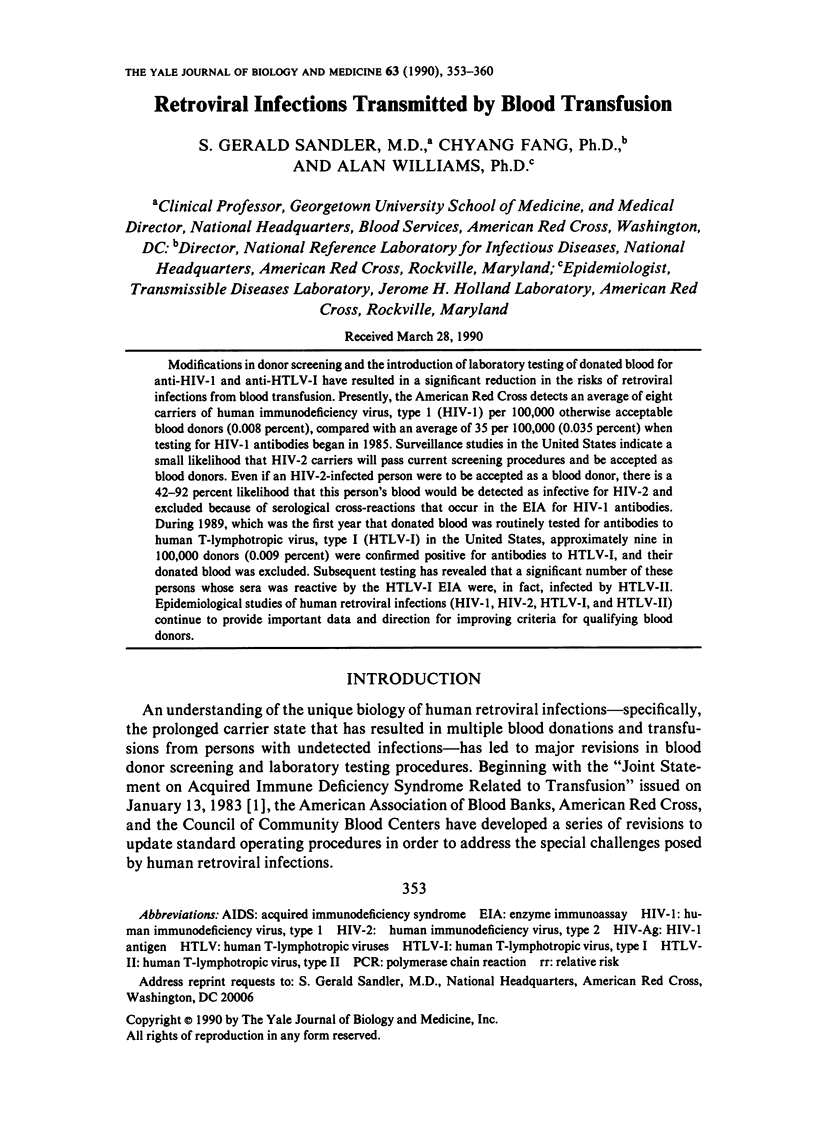
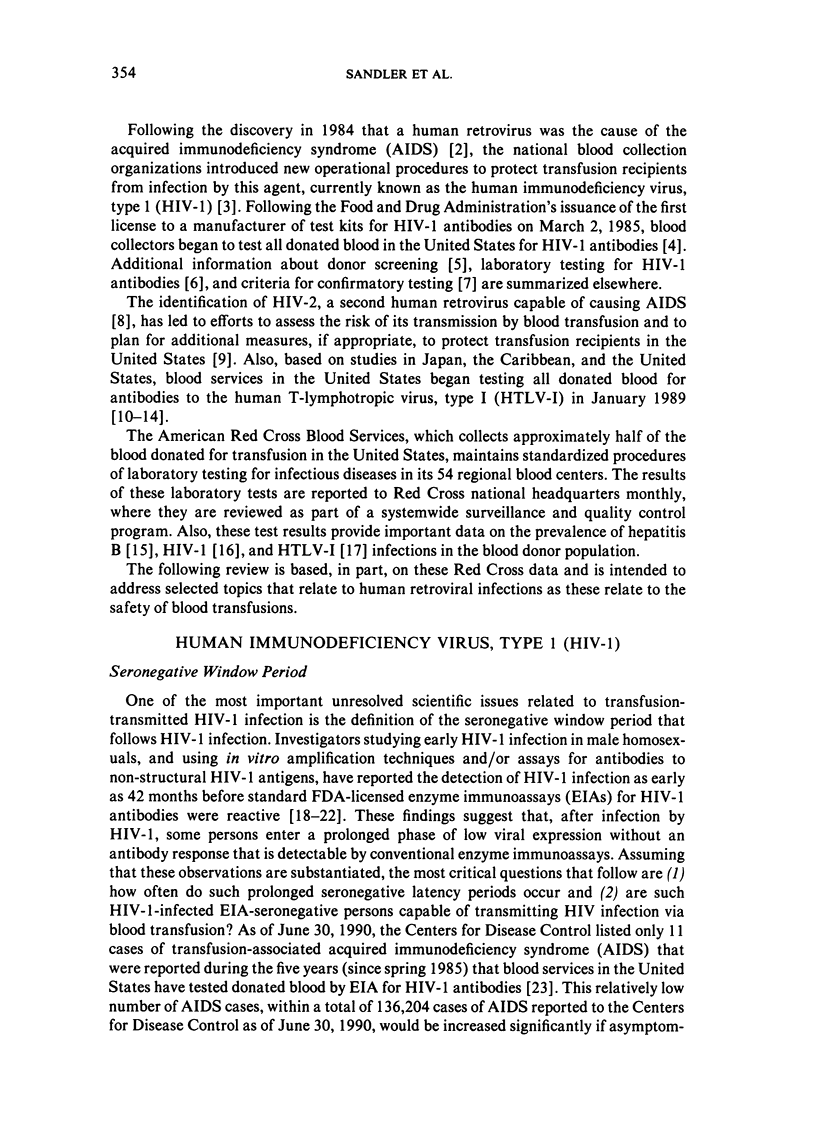
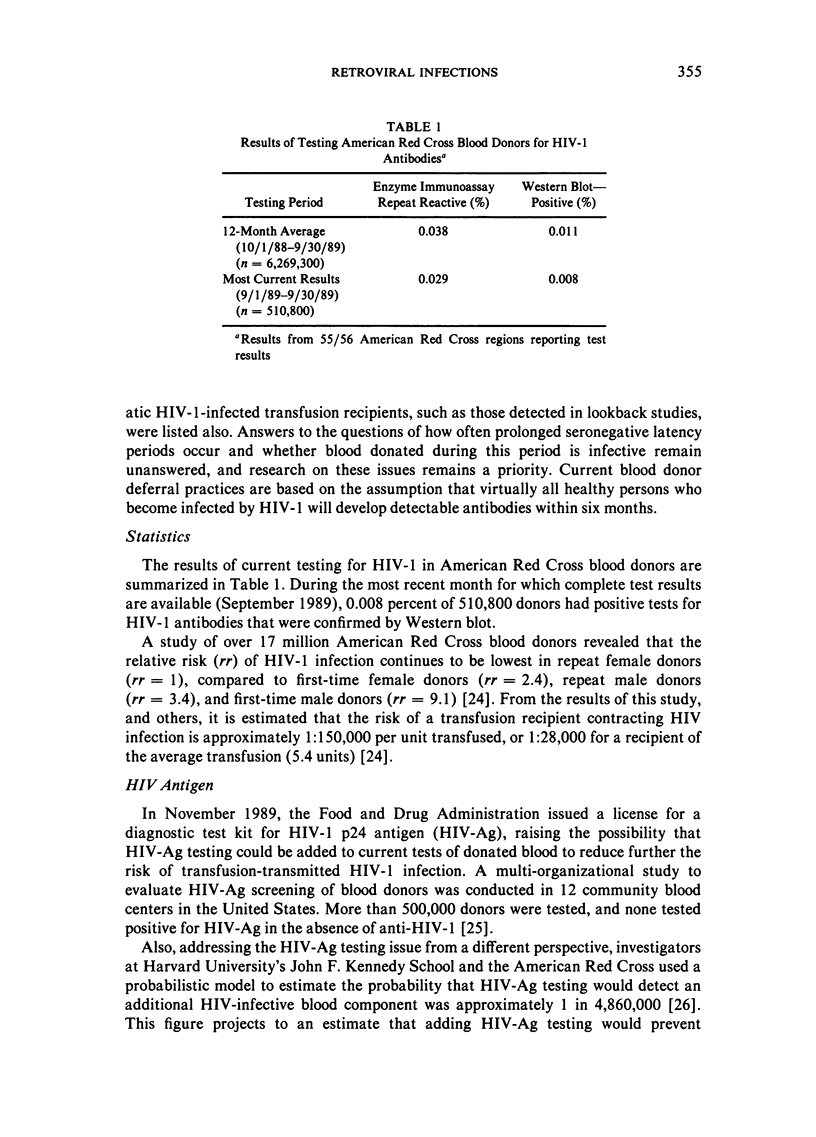
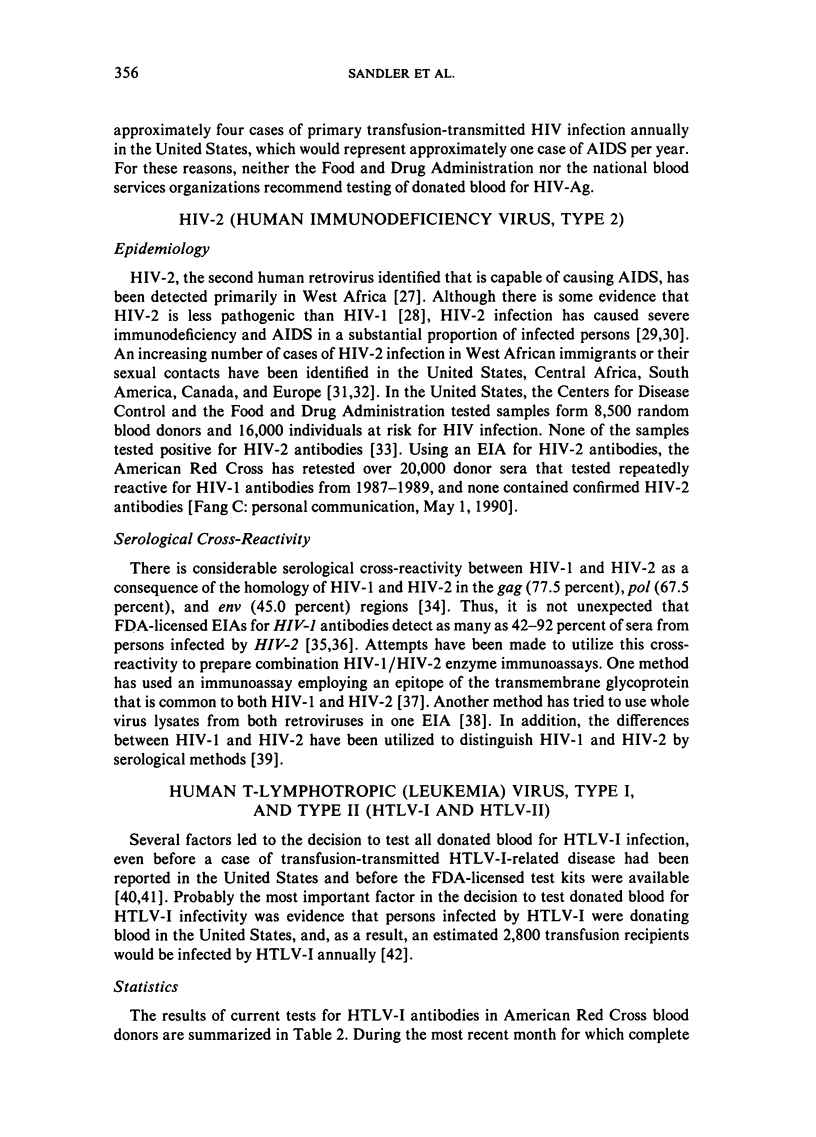
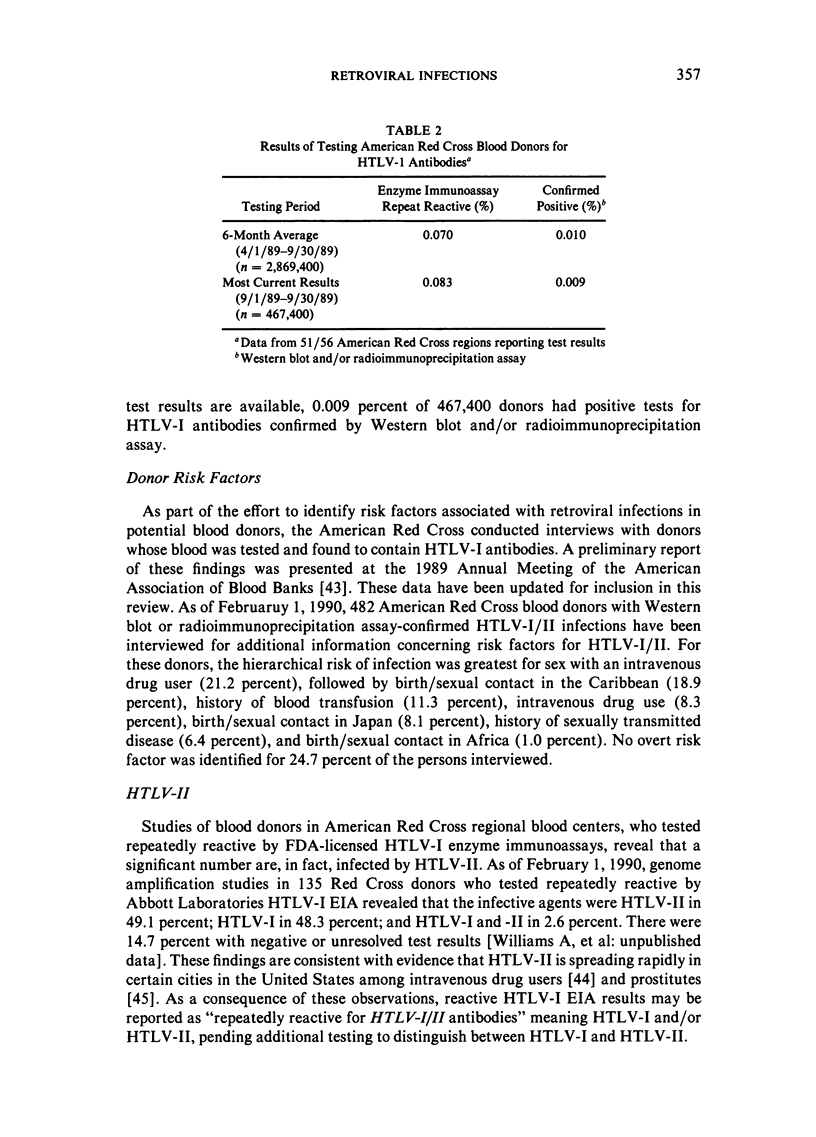
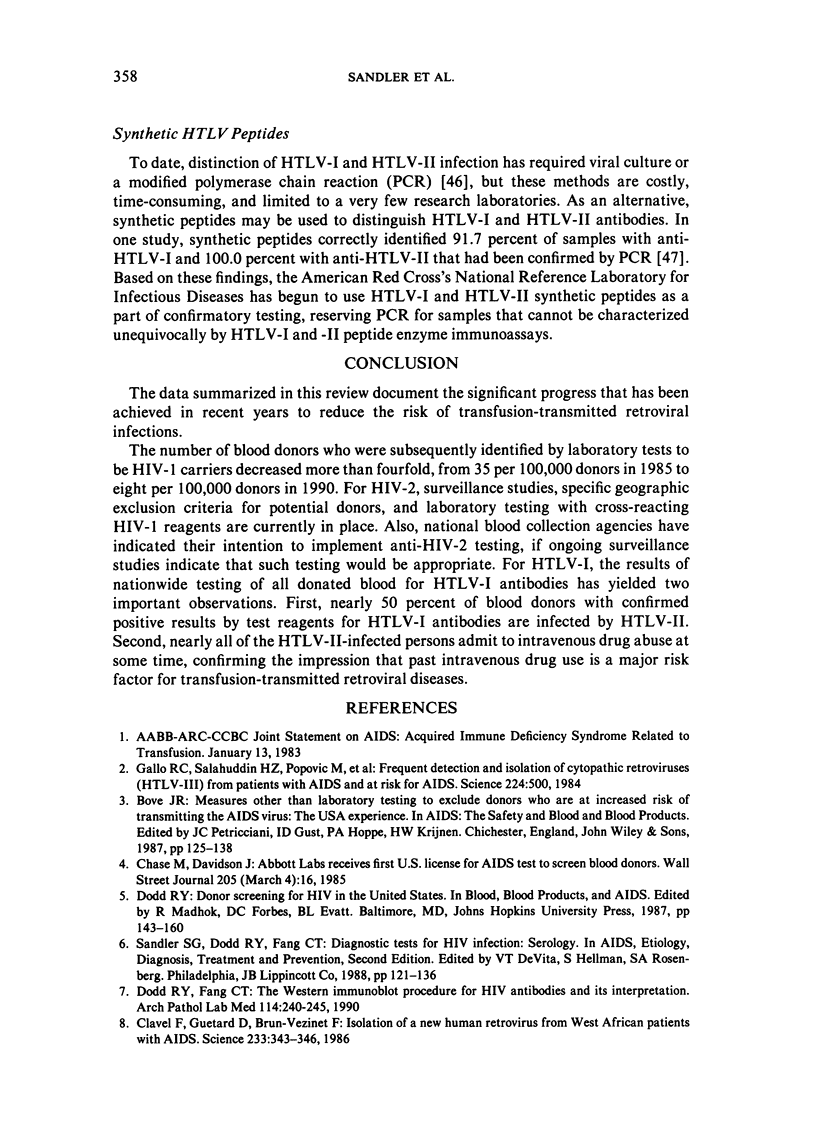
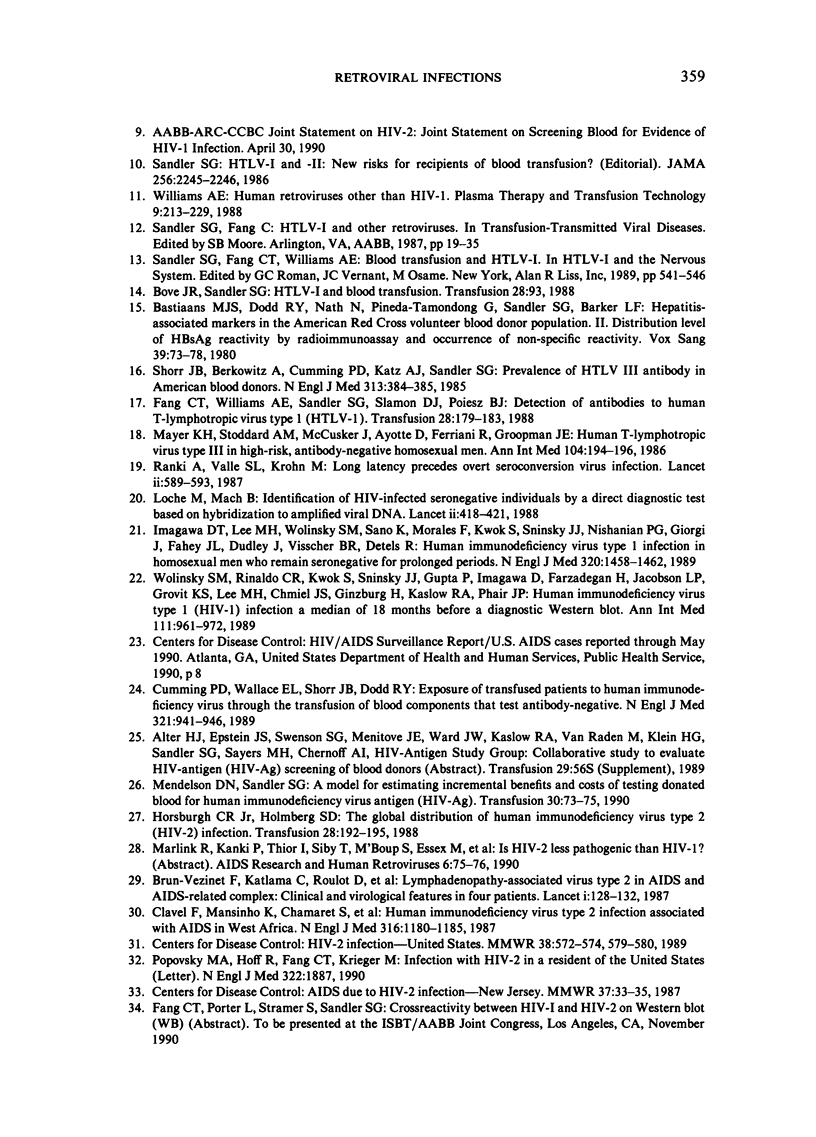
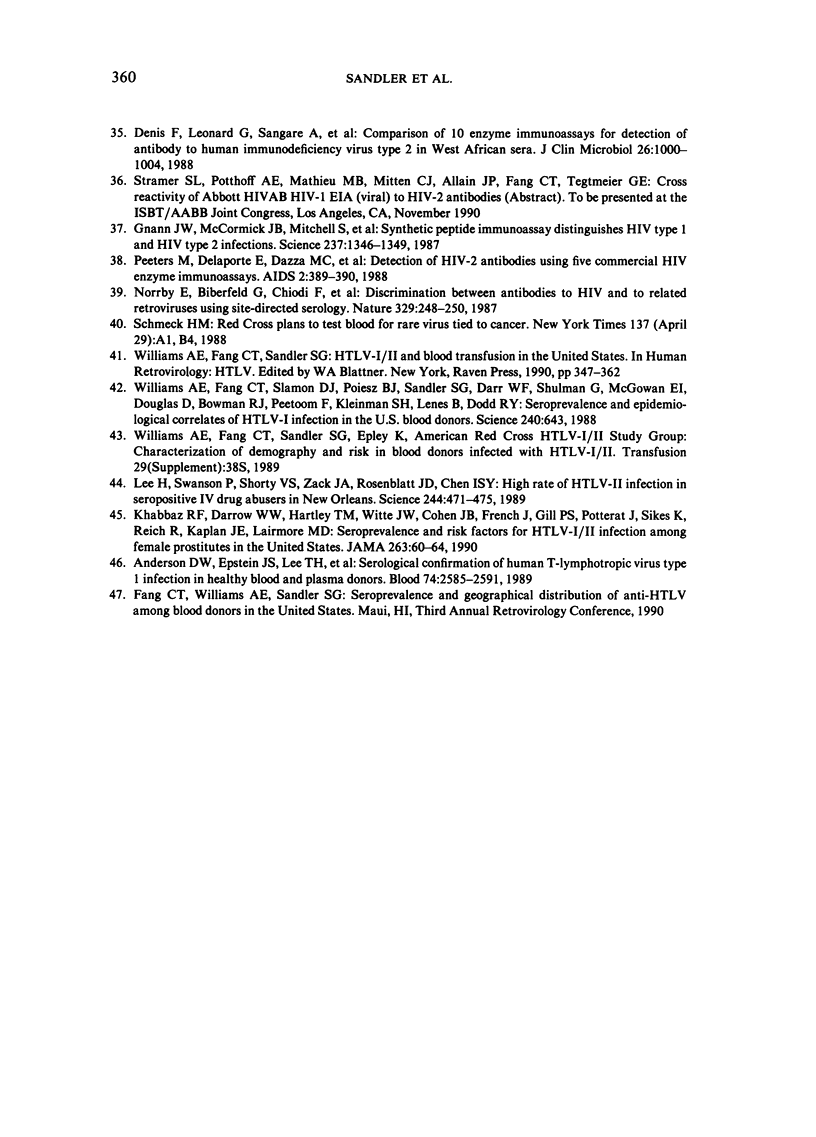
Selected References
These references are in PubMed. This may not be the complete list of references from this article.
- Anderson D. W., Epstein J. S., Lee T. H., Lairmore M. D., Saxinger C., Kalyanaraman V. S., Slamon D., Parks W., Poiesz B. J., Pierik L. T. Serological confirmation of human T-lymphotropic virus type I infection in healthy blood and plasma donors. Blood. 1989 Nov 15;74(7):2585–2591. [PubMed] [Google Scholar]
- Bove J. R., Sandler S. G. HTLV-1 and blood transfusion. Transfusion. 1988 Mar-Apr;28(2):93–94. doi: 10.1046/j.1537-2995.1988.28288179037.x. [DOI] [PubMed] [Google Scholar]
- Brun-Vezinet F., Rey M. A., Katlama C., Girard P. M., Roulot D., Yeni P., Lenoble L., Clavel F., Alizon M., Gadelle S. Lymphadenopathy-associated virus type 2 in AIDS and AIDS-related complex. Clinical and virological features in four patients. Lancet. 1987 Jan 17;1(8525):128–132. doi: 10.1016/s0140-6736(87)91967-2. [DOI] [PubMed] [Google Scholar]
- Centers for Disease Control (CDC) Update: HIV-2 infection--United States. MMWR Morb Mortal Wkly Rep. 1989 Aug 25;38(33):572-4, 579-80. [PubMed] [Google Scholar]
- Clavel F., Guétard D., Brun-Vézinet F., Chamaret S., Rey M. A., Santos-Ferreira M. O., Laurent A. G., Dauguet C., Katlama C., Rouzioux C. Isolation of a new human retrovirus from West African patients with AIDS. Science. 1986 Jul 18;233(4761):343–346. doi: 10.1126/science.2425430. [DOI] [PubMed] [Google Scholar]
- Clavel F., Mansinho K., Chamaret S., Guetard D., Favier V., Nina J., Santos-Ferreira M. O., Champalimaud J. L., Montagnier L. Human immunodeficiency virus type 2 infection associated with AIDS in West Africa. N Engl J Med. 1987 May 7;316(19):1180–1185. doi: 10.1056/NEJM198705073161903. [DOI] [PubMed] [Google Scholar]
- Cumming P. D., Wallace E. L., Schorr J. B., Dodd R. Y. Exposure of patients to human immunodeficiency virus through the transfusion of blood components that test antibody-negative. N Engl J Med. 1989 Oct 5;321(14):941–946. doi: 10.1056/NEJM198910053211405. [DOI] [PubMed] [Google Scholar]
- Denis F., Leonard G., Sangare A., Gershy-Damet G., Rey J. L., Soro B., Schmidt D., Mounier M., Verdier M., Baillou A. Comparison of 10 enzyme immunoassays for detection of antibody to human immunodeficiency virus type 2 in West African sera. J Clin Microbiol. 1988 May;26(5):1000–1004. doi: 10.1128/jcm.26.5.1000-1004.1988. [DOI] [PMC free article] [PubMed] [Google Scholar]
- Dodd R. Y., Fang C. T. The western immunoblot procedure for HIV antibodies and its interpretation. Arch Pathol Lab Med. 1990 Mar;114(3):240–245. [PubMed] [Google Scholar]
- Fang C. T., Williams A. E., Sandler S. G., Slamon D. J., Poiesz B. J. Detection of antibodies to human T-lymphotropic virus type 1 (HTLV-1). Transfusion. 1988 Mar-Apr;28(2):179–183. doi: 10.1046/j.1537-2995.1988.28288179027.x. [DOI] [PubMed] [Google Scholar]
- Gallo R. C., Salahuddin S. Z., Popovic M., Shearer G. M., Kaplan M., Haynes B. F., Palker T. J., Redfield R., Oleske J., Safai B. Frequent detection and isolation of cytopathic retroviruses (HTLV-III) from patients with AIDS and at risk for AIDS. Science. 1984 May 4;224(4648):500–503. doi: 10.1126/science.6200936. [DOI] [PubMed] [Google Scholar]
- Gnann J. W., Jr, McCormick J. B., Mitchell S., Nelson J. A., Oldstone M. B. Synthetic peptide immunoassay distinguishes HIV type 1 and HIV type 2 infections. Science. 1987 Sep 11;237(4820):1346–1349. doi: 10.1126/science.2888192. [DOI] [PubMed] [Google Scholar]
- Horsburgh C. R., Jr, Holmberg S. D. The global distribution of human immunodeficiency virus type 2 (HIV-2) infection. Transfusion. 1988 Mar-Apr;28(2):192–195. doi: 10.1046/j.1537-2995.1988.28288179031.x. [DOI] [PubMed] [Google Scholar]
- Imagawa D. T., Lee M. H., Wolinsky S. M., Sano K., Morales F., Kwok S., Sninsky J. J., Nishanian P. G., Giorgi J., Fahey J. L. Human immunodeficiency virus type 1 infection in homosexual men who remain seronegative for prolonged periods. N Engl J Med. 1989 Jun 1;320(22):1458–1462. doi: 10.1056/NEJM198906013202205. [DOI] [PubMed] [Google Scholar]
- Khabbaz R. F., Darrow W. W., Hartley T. M., Witte J., Cohen J. B., French J., Gill P. S., Potterat J., Sikes R. K., Reich R. Seroprevalence and risk factors for HTLV-I/II infection among female prostitutes in the United States. JAMA. 1990 Jan 5;263(1):60–64. [PubMed] [Google Scholar]
- Lee H., Swanson P., Shorty V. S., Zack J. A., Rosenblatt J. D., Chen I. S. High rate of HTLV-II infection in seropositive i.v. drug abusers in New Orleans. Science. 1989 Apr 28;244(4903):471–475. doi: 10.1126/science.2655084. [DOI] [PubMed] [Google Scholar]
- Loche M., Mach B. Identification of HIV-infected seronegative individuals by a direct diagnostic test based on hybridisation to amplified viral DNA. Lancet. 1988 Aug 20;2(8608):418–421. doi: 10.1016/s0140-6736(88)90412-6. [DOI] [PubMed] [Google Scholar]
- Mayer K. H., Stoddard A. M., McCusker J., Ayotte D., Ferriani R., Groopman J. E. Human T-lymphotropic virus type III in high-risk, antibody-negative homosexual men. Ann Intern Med. 1986 Feb;104(2):194–196. doi: 10.7326/0003-4819-104-2-194. [DOI] [PubMed] [Google Scholar]
- Mendelson D. N., Sandler S. G. A model for estimating incremental benefits and costs of testing donated blood for human immunodeficiency virus antigen (HIV-Ag). Transfusion. 1990 Jan;30(1):73–75. doi: 10.1046/j.1537-2995.1990.30190117637.x. [DOI] [PubMed] [Google Scholar]
- Nath N., Fang C. T., Berberian H., Bastiaans M. J., Dodd R. Y., Sandler S. G., Barker L. F. Hepatitis-associated markers in the American Red Cross volunteer blood donor population. ii. Distribution of level of HBsAg reactivity by radioimmunoassay and occurrence of nonspecific reactivity. Vox Sang. 1980 Aug;39(2):73–78. doi: 10.1111/j.1423-0410.1980.tb01840.x. [DOI] [PubMed] [Google Scholar]
- Norrby E., Biberfeld G., Chiodi F., von Gegerfeldt A., Nauclér A., Parks E., Lerner R. Discrimination between antibodies to HIV and to related retroviruses using site-directed serology. Nature. 1987 Sep 17;329(6136):248–250. doi: 10.1038/329248a0. [DOI] [PubMed] [Google Scholar]
- Peeters M., Delaporte E., Dazza M. C., Brun-Vézinet F. Detection of HIV-2 antibodies using five commercial HIV enzyme immunoassays. AIDS. 1988 Oct;2(5):389–390. doi: 10.1097/00002030-198810000-00010. [DOI] [PubMed] [Google Scholar]
- Popovsky M. A., Carneski A., Hoff R., Fang C. T., Krieger M. Infection with HIV-2 in a resident of the United States. N Engl J Med. 1990 Jun 28;322(26):1887–1887. doi: 10.1056/NEJM199006283222614. [DOI] [PubMed] [Google Scholar]
- Ranki A., Valle S. L., Krohn M., Antonen J., Allain J. P., Leuther M., Franchini G., Krohn K. Long latency precedes overt seroconversion in sexually transmitted human-immunodeficiency-virus infection. Lancet. 1987 Sep 12;2(8559):589–593. doi: 10.1016/s0140-6736(87)92985-0. [DOI] [PubMed] [Google Scholar]
- Sandler S. G. HTLV-I and -II. New risks for recipients of blood transfusions? JAMA. 1986 Oct 24;256(16):2245–2246. doi: 10.1001/jama.256.16.2245. [DOI] [PubMed] [Google Scholar]
- Schorr J. B., Berkowitz A., Cumming P. D., Katz A. J., Sandler S. G. Prevalence of HTLV-III antibody in American blood donors. N Engl J Med. 1985 Aug 8;313(6):384–385. doi: 10.1056/NEJM198508083130610. [DOI] [PubMed] [Google Scholar]
- Williams A. E., Fang C. T., Slamon D. J., Poiesz B. J., Sandler S. G., Darr W. F., 2nd, Shulman G., McGowan E. I., Douglas D. K., Bowman R. J. Seroprevalence and epidemiological correlates of HTLV-I infection in U.S. blood donors. Science. 1988 Apr 29;240(4852):643–646. doi: 10.1126/science.2896386. [DOI] [PubMed] [Google Scholar]
- Wolinsky S. M., Rinaldo C. R., Kwok S., Sninsky J. J., Gupta P., Imagawa D., Farzadegan H., Jacobson L. P., Grovit K. S., Lee M. H. Human immunodeficiency virus type 1 (HIV-1) infection a median of 18 months before a diagnostic western blot. Evidence from a cohort of homosexual men. Ann Intern Med. 1989 Dec 15;111(12):961–972. doi: 10.7326/0003-4819-111-12-961. [DOI] [PubMed] [Google Scholar]


